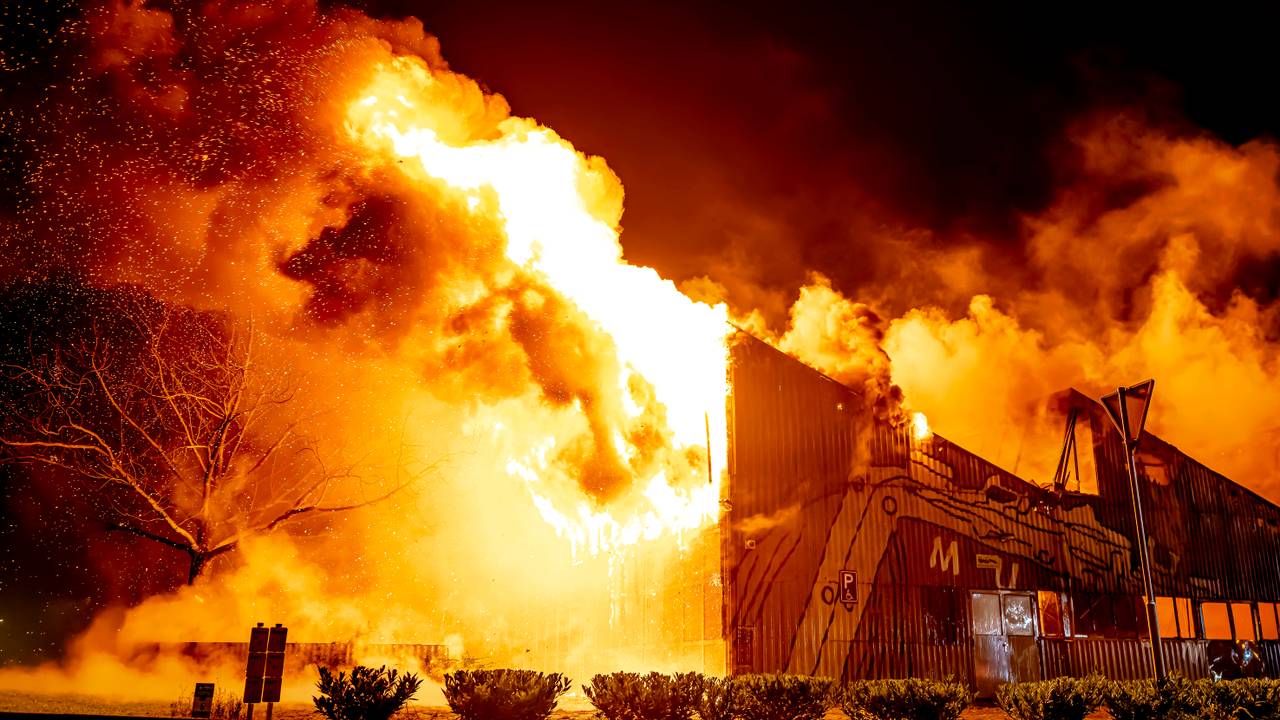Massive Fire Engulfs Former Museum in Waalwijk, Netherlands
Table of Contents
A important fire erupted late Monday night at the former Dutch leather and Shoe Museum, located on Elzenweg in Waalwijk, Netherlands. The blaze, which raged for several hours, prompted a large-scale emergency response and resulted in the release of asbestos into the surrounding area.
The fire department received the initial alarm around 10 p.m. Firefighters battled the inferno until approximately 2:45 a.m., finally extinguishing the flames around 4 a.m. The intensity of the fire was such that a portion of the building had to be demolished to prevent further spread.

Dramatic scenes unfolded as flames shot from the roof, creating a towering inferno visible from across the town. Thick plumes of smoke billowed across the Waalwijk city center, drifting northeastward.The sky above the area turned an ominous orange hue during the height of the fire.
authorities issued an NL-Alert, a nationwide emergency notification system, advising residents to stay away from the smoke, close windows and doors, and turn off mechanical ventilation systems. The swift and decisive action by emergency services prevented any injuries.
Asbestos Concerns
The fire released asbestos, a known carcinogen, into the atmosphere. Fire department hazmat teams are currently working to assess the extent of the contamination. “If you see particles lying around, they could also be other particles, such as from insulation material, then stay away from them and leave them behind,” cautioned a fire department spokesperson.This underscores the importance of avoiding contact with any debris from the fire.
The incident prompted a “Grip-1” response,signifying the need for coordinated efforts among various emergency services,including the fire department and police. A central command post was established near the scene to facilitate seamless collaboration.
Unconfirmed Reports
Reports circulated among onlookers that several young people were seen fleeing the area shortly before the fire started. However, a fire department spokesperson stated, “We are now mainly busy fighting the fire,” indicating that the reports were not yet confirmed.
The former museum, a building comprised of eight halls, suffered extensive damage. The two front halls were almost entirely destroyed. The fire department noted the significant amount of water required to extinguish the blaze, necessitating the use of additional water trucks and a temporary water transport system.
The response involved eight fire engines, two aerial platforms, two water tankers, a hazardous materials specialist, a duty officer, and a chief duty officer. The museum had been closed to the public since January 2017, though a historical mural remains on the building’s exterior.
This incident highlights the potential dangers of aging buildings and the importance of prompt emergency response in situations involving hazardous materials. The inquiry into the cause of the fire is ongoing.
Netherlands Fire: Asbestos Concerns and Questions after Massive Museum Blaze
A massive fire ripped through the former Dutch Leather and Shoe Museum in Waalwijk Monday night, prompting a large-scale emergency response and raising concerns about asbestos contamination in the surrounding area.
The blaze,visible for miles across the town,raged for several hours before being finally extinguished early Tuesday morning. This interview explores the incident’s impact with Dr.Emily van der Linde, a specialist in fire safety and hazardous materials.
Extent of the Damage
Senior Editor: Dr. van der Linde, can you give us your initial assessment of the damage caused by the fire at the former museum?
Dr. van der Linde: This was indeed a significant fire. early reports indicate that the two front halls of the eight-hall building were almost entirely destroyed. The fire department had to demolish part of the structure to prevent its further spread, which highlights the intensity of the blaze.
Asbestos Release and Public Health Risks
Senior Editor: There are reports of asbestos released into the atmosphere. How serious is this, and what precautions should Waalwijk residents take?
Dr. van der Linde: Asbestos is a known carcinogen, so its release during a fire is a serious concern. Authorities issued an NL-Alert, correctly advising residents to stay away from smoke, close windows and doors, and turn off ventilation systems. It’s crucial to avoid contact with any debris from the fire site, as it may contain asbestos particles. HAZMAT teams are currently assessing the contamination, and their findings will dictate further steps.
Causes Under Investigation
Senior Editor: Do we certainly know yet what caused the fire?
Dr. van der Linde: The cause of the fire is currently under investigation. There were unconfirmed reports of people fleeing the area shortly before the fire started, but the fire department is focusing on extinguishing the blaze and containing the asbestos risk at this time.
Challenges of Fighting Fires in Aging Buildings
Senior Editor: Flammable materials and the structure of the museum building likely played a role in the fire’s intensity. What challenges do firefighters typically face when battling blazes in older buildings?
Dr. van der Linde: Older buildings often have outdated fire safety features and sometimes contain materials that are more combustible than modern alternatives.
These factors can contribute to the rapid spread of fire. In this case, the fire department needed significant water resources and likely faced logistical challenges due to the age and size of the building.
Preventing Future Tragedies
Senior Editor: What lessons can be learned from this incident to prevent future tragedies?
Dr. van der Linde: This fire underscores the importance of rigorous fire safety inspections and maintenance for older buildings, especially those containing hazardous materials like asbestos. Moreover, it highlights the critical role of prompt emergency response and the need for coordinated action between fire departments, HAZMAT teams, and public health officials in situations involving hazardous materials.
